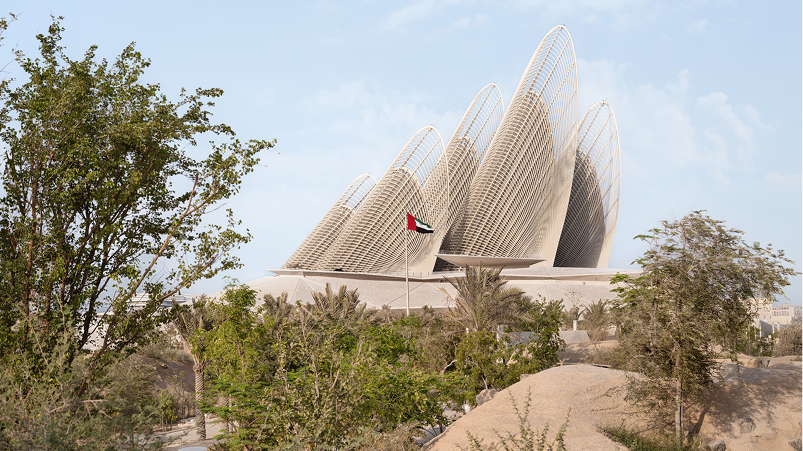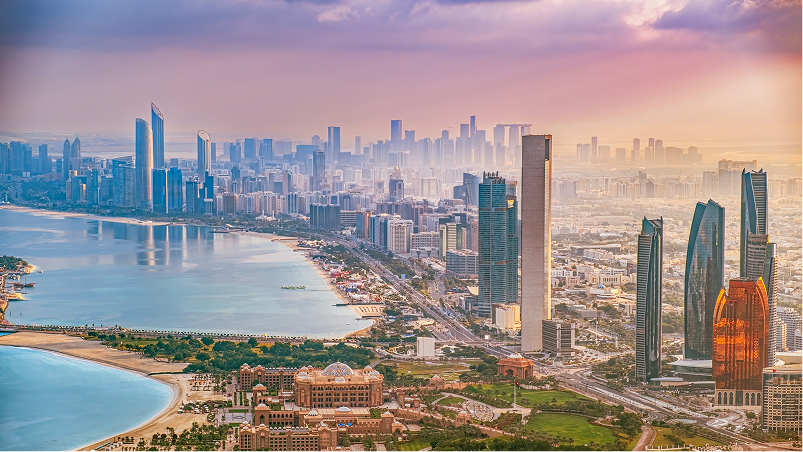
The first modern chapter began after oil discovery in the late 1950s. By the 1960s and early 1970s, Abu Dhabi started replacing its traditional dwellings with planned streets, government buildings, and early high-rises. The skyline was modest but symbolic — a sign that the capital was preparing for its new role. The Corniche began to take shape, ministries appeared, and the city stretched along the water rather than upward.
A clearer architectural boom arrived in the 1990s and early 2000s. Towers began to cluster along the Corniche, Al Markaziyah, and the emerging business districts. Abu Dhabi’s skyline became recognisable: sleek façades reflecting the gulf light, geometric silhouettes, and the early landmarks that would anchor the city’s image. Etihad Towers, with its five sculptural forms leaning toward the water, became one of the clearest modern icons.
But the most transformative phase came slightly later, when Abu Dhabi turned toward cultural and architectural identity building. The city decided it wouldn’t only compete in scale — it would define itself through meaning. That decision produced one of the most striking collections of cultural architecture anywhere in the region.

The Sheikh Zayed Grand Mosque, completed in 2007, became the heart of this vision. With its 82 domes, reflective pools, white marble, and the largest hand-knotted carpet in the world, the mosque is both a masterpiece of craftsmanship and a national symbol. It anchors not just the skyline but the emotional landscape of the city.
Then came Saadiyat Island, Abu Dhabi’s cultural district – one of the most ambitious architectural concentrations in the Middle East. Here, the Louvre Abu Dhabi opened in 2017 under a floating dome of perforated metal, designed by Jean Nouvel to cast shifting ‘rain of light’ patterns across the courtyards. The Guggenheim Abu Dhabi by Frank Gehry, Zayed National Museum by Foster + Partners, and the Natural History Museum Abu Dhabi by Mecanoo are set to expand this cultural cluster further, turning the island into a global destination for art, science, and heritage.
Alongside the cultural boom, the city developed new business and residential areas that reshaped the skyline again. Reem Island’s glass towers, Al Maryah Island’s financial district, and the newer projects along the Corniche brought a sense of density and height, though still more measured than Dubai’s vertical rush. Abu Dhabi remains a city that prioritises space and light — towers rarely crowd one another, and the water remains the main reference point.

The capital also carries a collection of culturally significant sites that deepen its architectural identity. Qasr Al Hosn, the oldest surviving building in the city, stands in restored form as a reminder of Abu Dhabi’s origins — a watchtower built in 1790 to protect the island’s freshwater well. Nearby, the House of Artisans, the Cultural Foundation, and Manarat Al Saadiyat form a quiet grid of cultural anchors that balance the modern skyline with local history.
Even the newer developments carry this duality. Qasr Al Watan, the Presidential Palace, opened to the public in 2019, is a blend of modern engineering and traditional motifs — domes, geometric carvings, and a vast ceremonial hall designed not as a showpiece but as a statement of national openness. And the Abu Dhabi Falcon Hospital, the mangrove boardwalks, and the planned museums form a network of places where culture, nature, and modern life intersect.
Through each stage of growth, Abu Dhabi has built with intention. Its skyline didn’t appear overnight; it unfolded from government districts to modern high-rises, then from high-rises to cultural icons. Today, the capital holds some of the most significant architectural landmarks in the region — not just for their forms, but for what they represent: unity, heritage, openness to the world, and the UAE’s vision of progress grounded in identity.


.png)
.png)
.png)
.png)
